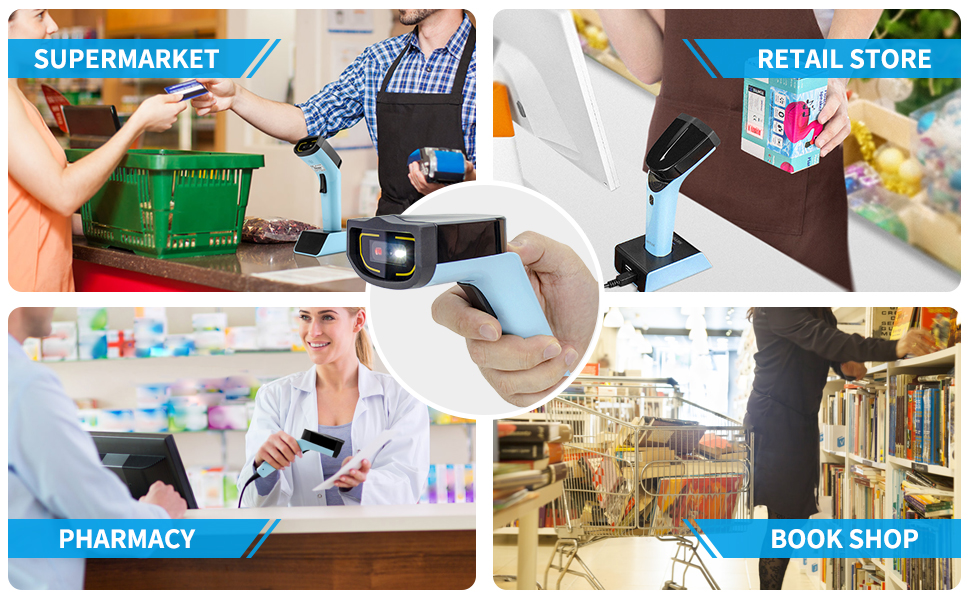Introduction: A Critical Component of Industrial Automation
In today's wave of digital transformation, industrial barcode scanners have become a core link connecting the physical world with digital systems. As professional-grade automatic identification devices, industrial barcode scanner not only enable rapid data collection of item information but also drive intelligent transformation of production processes through real-time data interaction. From automotive manufacturing to pharmaceutical distribution, from warehousing logistics to retail services, industrial barcode scanners are reshaping operational models across industries with their outstanding performance.
Core Technology Analysis
Modern industrial barcode scanners integrate multiple cutting-edge technologies: high-resolution CMOS sensors coupled with multi-spectral illumination systems ensure accurate identification even in complex lighting environments; advanced decoding algorithms can automatically repair damaged or blurred barcodes, with a maximum recognition angle of up to 60 degrees; industrial-grade processors achieve millisecond-level decoding speeds, with typical products capable of processing over 20 scans per second. Data from a renowned automaker shows that after adopting a new-generation scanning system, production line recognition accuracy reached 99.99%, improving by two orders of magnitude compared to traditional methods.

Exceptional Environmental Adaptability
To meet the stringent requirements of industrial scenarios, industrial barcode scanner feature all-metal housings and shock-resistant designs, certified with IP67/IP68 protection ratings, capable of withstanding drops from 1.5 meters and high-pressure water jets. Wide-temperature models operate reliably from -30°C to 50°C, while special explosion-proof versions are suitable for hazardous environments like oil and chemical plants. In cold chain logistics, freeze-resistant scanners achieve stable operation for 8 continuous hours at -25°C, solving technical challenges in frozen product traceability.
Real-Time Data Empowers Smart Manufacturing
Through wireless industrial barcode scanner technologies like 5G and Wi-Fi 6, industrial scanners enable real-time synchronization of scan data with enterprise systems. A case study from a smart factory of a home appliance manufacturer shows that the delay from production line scanning to MES system updates is controlled within 80 milliseconds, making work-in-progress inventory visualization a reality. This immediacy delivers significant benefits: average response time to production anomalies is reduced from 4 hours to 15 minutes, while material traceability efficiency improves by over 90%.
Deep Integration in Manufacturing
Within the smart manufacturing framework, scanning technology has evolved from a simple identification function to a full-process control node. The electronics manufacturing industry has established complete digital twins from raw materials to finished products by deploying fixed scanners at each production stage. Applications at a PCB factory demonstrate that such traceability systems reduce quality issue diagnosis time from 8 hours to 10 minutes, while the correlation analysis between equipment status codes and product codes provides data support for predictive maintenance.
Revolutionary Breakthroughs in Logistics
Industrial scanners have completely transformed logistics operations: automated sorting line scanning speeds exceed 3,000 items per hour, six times more efficient than manual processing; smart container identification reduces customs clearance time by 70%; dynamic scanning technology integrated with GIS systems enables end-to-end temperature control data traceability for cold chain logistics. Practices at a leading domestic logistics company show these innovations help reduce operating costs by 22% and improve customer satisfaction by 35 percentage points.
Cross-Industry Application Expansion
The healthcare sector implements "one-drug-one-code" management through medical-grade scanners, with statistics from a provincial hospital showing medication error rates dropping to zero. The aviation maintenance industry uses explosion-proof scanners to quickly access aircraft material records, reducing single maintenance durations by 40%. Even in agricultural production, waterproof and dustproof scanners facilitate farm product traceability, allowing consumers to view full supply chain information from cultivation to distribution with a simple scan. These cross-industry applications demonstrate the powerful adaptability of industrial scanning technology.
Future Development Trends
Industrial scanning technology continues to evolve along three dimensions: deep learning-based smart recognition can simultaneously decode barcodes, OCR characters, and 3D object shapes; 5G edge computing compresses data processing latency to under 10 milliseconds; AR augmented reality projects scan information directly into the operator's field of view. With integration into IoT platforms, scanning devices will upgrade from mere data collectors to intelligent terminals with edge computing capabilities, providing stronger foundational support for Industry 4.0 and smart manufacturing.
Conclusion: A Core Enabler of Digital Transformation
The development journey of industrial barcode scanners reflects the trajectory of manufacturing digital transformation. From simple initial identification to today's smart data terminals, they not only enhance operational efficiency but also restructure business processes. As technological innovation continues, industrial scanners will undoubtedly play a pivotal role in broader fields, accelerating various industries toward digitalization, networking, and intelligent transformation. For enterprises, seizing the opportunities brought by scanning technology innovation will be a strategic choice to gain a first-mover advantage in digital transformation.

